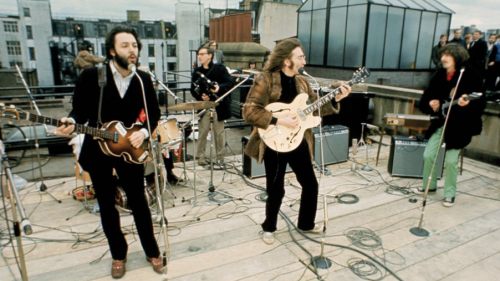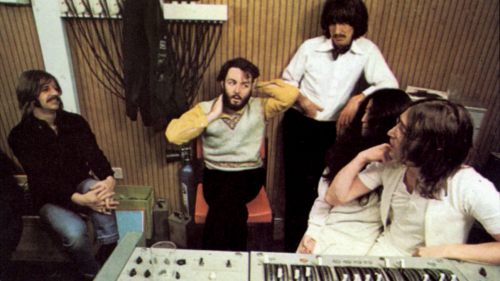Best Movies Ever: A HARD DAY’S NIGHT (1964)
A Hard Day’s Night doesn’t so much begin as it explodes into existence, that ringing first chord shattering the quiet of the movie theater as the Beatles, mid-chase, run towards the camera. The film rarely backs down from this exuberant energy, barreling ahead with a constant cartoonish smile. It’s amazing.
We can talk about the ways that A Hard Day’s Night profoundly influenced our culture (watch the Can’t Buy Me Love sequence to see the framework of fifty years worth of pop music visualizations) but why bother when we can talk about how good A Hard Day’s Night is? Yes, the film is important but, like the equally important Beatles, it’s also a frenetic good time. This is a fun movie.
There’s not much story to A Hard Day’s Night - the band travels to London for a TV gig and Paul’s irascible grandfather gets them into some minor trouble along the way - but the looseness of the structure is the key to the film’s immense joyfulness. The Fab Four get to run and jump and mug their way through barely-connected scenarios, always aiming at optimal fun. There’s a constant cartoony energy that sails the film from scene to scene, taking occasional breaks for The Beatles to play a song.
Watching A Hard Day’s Night fifty years on it’s amazing to see how the band members’ personalities are already in place. John Lennon is a surrealist, a combination of Groucho and Harpo Marx with an edge of darkness. Paul McCartney’s suave, laidback cuteness is there right from the start as he hides behind a newspaper as the other Beatles scramble away from girls. George Harrison seems serious, but he’s really deadpan, and his honesty in the scene where he ends up in a marketing meeting foreshadows his interest in Eastern mysticism. And then there’s Ringo, the sad clown of the group, the one Beatle who openly wept when the band broke up. Each of these characters would come to define the Beatles throughout the remaining six years of their shared career.
Director Richard Lester used a handheld camera for much of the film, giving A Hard Day’s Night the aesthetics of a documentary, blurring the lines between those characters and the real Beatles. That semi-doc style makes the film’s more outrageous moments - John disappearing in the bathtub, Ringo helping a lady fall into a hole - pack an even bigger punch. Their next film, Help!, is big and broad from the start, and so the surrealism and absurdity of the Beatles’ humor doesn’t stand out as starkly as it does here, in black and white.
The dialogue balances perfectly between Liverpudlian working class pith and exquisite wordplay and wit. Screenwriter Alun Owen hung out with the Fab Four, getting to know their lifestyle but also their way with words; many of the most famous jokes in the movie - Ringo’s claim that he’s not a mod or a rocker but rather a mocker, for instance - came from The Beatles themselves. Owen’s script, like Lester’s direction, is perfectly naturalistic until it’s time for it to not be naturalistic; there’s an inherent playfulness that tests the boundaries of realism.
That playfulness is the key to the spirit of the early Beatles. By the time of A Hard Day’s Night The Beatles were young men but no longer children; they had done time in the red-light district of Hamburg’s Reeperbahn, playing clubs, sleeping behind the stage, binging on amphetamines and losing Stu Sutcliffe. But they still had that boyish sense of play, a charm and energy that radiates from the black and white screen and glows in their often slightly-sweaty faces. You’d use words like ‘frolic’ to describe the way The Beatles caper about the frame. But that capering is undercut with the slightest edge, as in the scene where Lennon is mugging around with a bottle of Coke and holds it up to his nose to take a couple of surreptitious toots. Moments later the Fab Four have materialized outside that same train car, begging a stodgy passenger to give them their ball back. They could charm the screaming 12 year olds and then fuck their mothers. The Beatles were never as outwardly dangerous as the Rolling Stones, but they certainly were never as safe as Beatlemania would have you believe.
Beatlemania was the original title of the film, and it’s a thread that runs throughout. The Beatles are constantly swarmed by throngs of shrieking pre-teens (we’d call them tweens today, and they’re crying about Justin Bieber on YouTube now), and these mobs have the menace of a swarm of running zombies. They’re a representation of the out-of-control nature of the fame that found these four musicians, a fame that came up out of nowhere with the sudden ferocity of a punch in the face. When Owen was researching the movie he realized that these four young men were imprisoned, that their lives were "a train and a room and a car and a room and a room and a room,” and he even put that line in the movie, coming from Paul’s clean grandfather. The Beatles’ very faces get them entry wherever they like, and the times when people don’t recognize them (or sort of recognize them, as when John is stopped in a hallway by a woman who says “You look just like him,” without saying who) are played as jokes. It’s stranger for a Beatle to be unseen than to be chased.
That prison of fame is what allowed the band to make a movie like this. A Hard Day’s Night was intended as sheer exploitation, an excuse to release a soundtrack album that would sell tons (the title song was only written six days before shooting was completed. When the decision came to change the title to A Hard Day’s Night (inspired by one of Ringo’s many Yogi Berra-like malapropisms) John went off to write a new song with that title, and did it in one night. Listen to that song. He wrote it OVERNIGHT). Looking back now it’s obvious that The Beatles would have more to offer than just a cheapie teen movie, but in 1964 the band’s headiest days were still years off. But Lester understood the subversion available in pop, and he exploited the record company, who was hoping to exploit the audience.
There’s a wonderful current of satire that runs just underneath the surface of A Hard Day’s Night. The film playfully skewers the boys themselves (making them out to be sort of assholes at one point as they drive sad Ringo off) but also takes aim at TV and marketing and the whole of English society. Anarchy powers much of A Hard Day’s Night, mixed with a healthy dose of anti-authoritarianism. This would bloom at the end of the 60s, but here it comes in a more innocent form, with the police portrayed as Keystone Kops and establishment figures as blowhards. The Beatles' politics are still at the Bugs Bunny level here. The film takes nothing seriously - except for the music.
Lester’s style of shooting the performances, using multiple angles, is pretty much ground zero for how we expect to see performances shot today, and it’s why MTV anointed him the ‘Father of the Music Video.’ What makes the performances in A Hard Day’s Night stand out isn’t the technical decision to cover from all sorts of angles, but the way The Beatles themselves interact. They smile and nod and are playful together; they might be lip synching to pre-recorded tracks, but that doesn’t keep them from having the energy of a team in perfect harmony. That Richard Lester was a visionary filmmaker helps secure A Hard Day’s Night its spot as one of the best movies ever made, but even he couldn’t have pulled that off without the effortless chemistry of the Fab Four.
A Hard Day’s Night sends you out of the theater slightly exhausted from the laughs and the songs but also energized by the ebullient life force of the Beatles themselves. When you see how quick, how engaged, how excited The Beatles were their entire career makes more sense. Sgt. Pepper’s Lonely Hearts Club Band was released only three years after A Hard Day’s Night; the band itself would come to an end in just six years. The difference between these four and the four who stood atop Apple Records, playing their farewell gig, is astonishing. And while I will always like the later Beatles the best, I am absolutely powerless before the onslaught of pop cheerfulness that pours from every frame of A Hard Day’s Night, the greatest rock movie ever made.
A Hard Day's Night is now in a limited theatrical rerelease, and it should be seen on the big screen. It is also available in a newly remastered form through the Criterion Collection.



